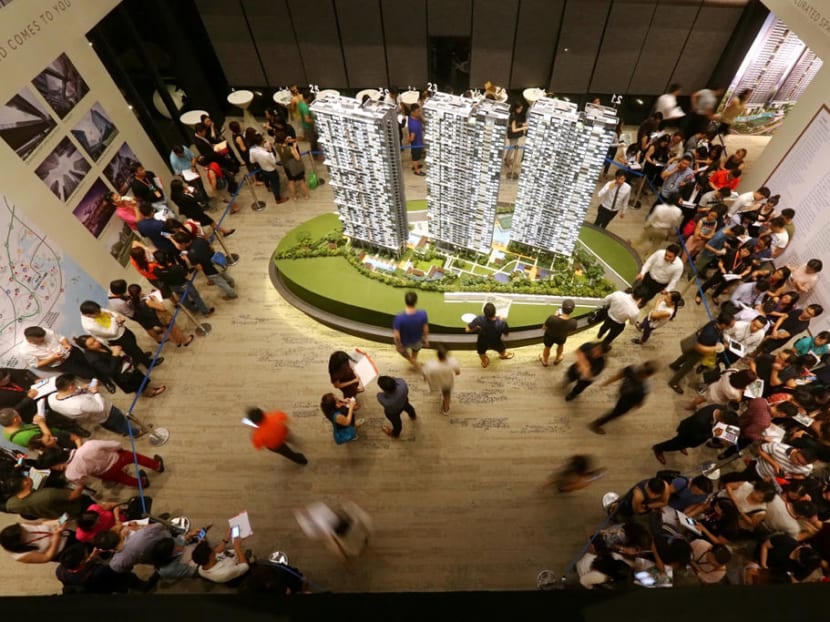Sales of new private homes surge in July on panic-buying, analysts say strong showing an anomaly
SINGAPORE — More than 1,720 new private homes were sold in July, a 55-per-cent jump compared with the same period last year and almost thrice the number sold in June.

SINGAPORE — More than 1,720 new private homes were sold in July, a 55-per-cent jump compared with the same period last year and almost thrice the number sold in June.
These were the latest figures released by the Urban Redevelopment Authority (URA) on Wednesday (Aug 15).
The surge was largely due to the last-minute buying frenzy on July 5, when buyers rushed in to snap up residential units to avoid the Government’s cooling measures which kicked in the next day.
Calling the overwhelming performance “skewed” and a “distortion of true market conditions”, analysts generally agreed that July’s sales would be a one-off incident, as buying sentiment for the upcoming months would be hit by the cooling measures as well as the annual Hungry Ghost Festival, which is generally regarded by some Chinese as an inauspicious month to buy properties.
About 1,000 apartments across three new projects — Park Colonial, Riverfront Residences and Stirling Residences — were reportedly transacted on the evening of July 5 in under five hours, making up 60 per cent of sales for the whole month.
Developers brought forward the launch dates for these projects after the Government announced property curbs including higher Additional Buyers' Stamp Duty rates and tighter loan-to-value limits which apply to housing loans granted by financial institutions.
Industry players had earlier told TODAY that during the buying frenzy, about 300 units were sold at Park Colonial, while more than 500 units at Riverfront Residences and about 200 units at Stirling Residence were transacted. These figures were confirmed by analysts after the release of Wednesday’s figures.
Based on URA's data, Park Colonial condominium, which is located near Woodleigh MRT Station in Upper Serangoon, sold 429 units out of the 805 put up for sale last month. The median transaction price was S$1,750 psf.
Riverfront Residences in Hougang sold 628 of the 800 units launched, at an average price of S$1,300 psf.
And for Stirling Residences in Queenstown, the developer sold 339 of the 380 launched, at about S$1,750 psf.
Daintree Residence, the first private residential project to open for sale after the property curbs took effect, sold 46 out of 80 units launched. The average transaction price for the Upper Bukit Timah project was S$1,710 psf, which was 5 per cent lower than the earlier announced price of S$1,800 psf.
TODAY reported that some property developers were lowering the prices of their residential projects by about 5 to 10 per cent after the cooling measures, in a bid to attract more buyers.
Despite these carrots, analysts expect the sales of new private apartments to decline in the coming months, exacerbated by the Hungry Ghost Festival, and then stabilise after that.
FUTURE SALES WILL NOT BE AS BUOYANT
However, Mr Nicholas Mak, executive director of real estate investment firm ZACD Group, said that sales will not return to the levels before the cooling measures, even if they pick up after the Hungry Ghost month.
Several property analysts believe that buyers will be waiting on the sidelines and taking time to make up their minds as they assess market conditions in the wake of the property curbs.
Mr Eugene Lim, key executive officer of real estate agency ERA, explained that even though affordability is not an issue for most buyers, there is no longer a “feel-good” factor.
He added that some owners who have sold their private homes in the last few weeks have chosen to rent apartments instead of buying new ones because they believe that prices will fall.
However, most developers will not be cutting prices significantly, Mr Mak said, as the development costs have been locked in for their projects. This means that there could be a mismatch in expectations between developers and buyers.
In their forecast of total sales of new private residential units for the whole year, the analysts put the figure at about 8,500, which is nearly 20 per cent lower than the 10,500 units sold last year.
Mr Mak added that if the cooling measures had not been imposed, this figure could be higher, at between 10,000 and 12,000 units.
HIGH SUPPLY, FIRST-TIME BUYERS KEPT SALES GOING
Notwithstanding the one-off spike in July’s sales, some analysts noted that there is still healthy demand judging by the number of units sold after the cooling measures kicked in for the rest of the month. These made up 40 per cent of sales for the whole month.
Excluding the numbers sold during the buying frenzy, Park Colonial, Riverfront Residences and Stirling Residences continued to sell more than 100 units each. Ms Tricia Song, head of research for Singapore at real estate services firm Colliers International, considered this as reflecting “reasonable demand”.
Ms Christine Sun, head of research and consultancy at real estate firm OrangeTee, called the 40 per cent volume a “high percentage”, and said that “sales were still relatively quite healthy”, being mainly driven by first-time private home buyers who are less affected by the curbs.
“We observed a shift in buyers’ preference for bigger units after the cooling measures… (indicating that) there are more owner-occupiers than investors,” Ms Sun said.
Ms Christine Li, senior director of research at real estate services firm Cushman and Wakefield, agreed that there is still strong latent demand for “well-priced and affordable mass market homes” in Singapore.
However, Mr Desmond Sim, head of research for Singapore and South-east Asia at real estate services firm CBRE, said that while sales momentum did continue after the cooling measures, it was at a slower pace.
Another analyst attributed the sales momentum to the huge number of new units launched, which was the highest in a single month since March 2013. Mr Ong Teck Hui, national director of research and consultancy at real estate management firm JLL, said this then presented “abundant opportunities” for buyers.
“However, an analysis of secondary market caveats in July shows a significant slowing trend compared to previous months,” he added.








